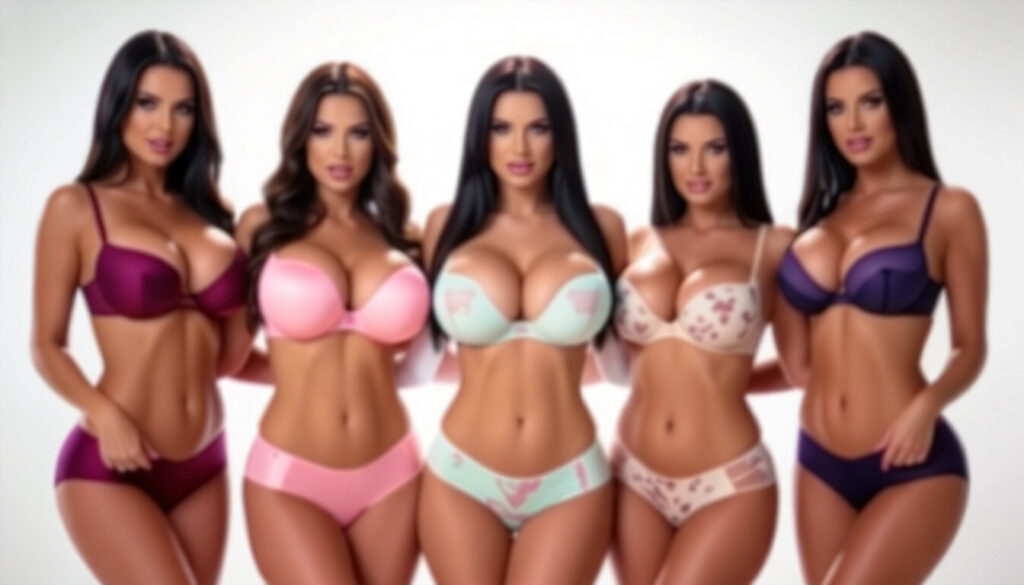Blunt question: why are so many anime girls and real selfies suddenly defying gravity on your screen? It’s not your imagination—it’s a wave. Tools that generate AI-powered bouncing breasts are flooding adult forums, artist communities, meme pages, and even experimental NSFW chatbot platforms. Sitting at the weird crossroads of internet humor, sex tech, fan edits, and digital animation, they’re more viral than subtle. Whether it’s your favorite waifu with suddenly-animated physics or a hyperreal selfie-turned-porn-GIF, these tools are built for one thing: motion that grabs attention. And it’s working.
The Digital Trick Behind The Bounce
These animations begin with a static input—think selfies, anime art, or even crude doodles. AI models analyze the image to identify key body zones, adding movement using rigging frameworks or motion-enhancement filters. Some rely entirely on deepfake code borrowed and tweaked from video face-swapping tech. Others merge neural rendering with classic animation principles—picture cartoon physics with a hormonal upgrade.
Common tools include:
- Deep neural networks trained on adult content or anime illustrations
- Physics engines simulating soft body inertia and elasticity
- Image-to-motion apps with jiggle filters, mesh deformation, or pixel warping
Basically, picture boob physics from your favorite video games, only now it’s available in DIY form for any image you upload.
More Than Just Porn: How This Content Shows Up
This surge isn’t just hitting porn sites. You’ll find AI-generated jiggle edits in:
| Type | Where It Appears | What’s Being Edited |
|---|---|---|
| Anime and Waifu Clips | Reddit, Discord, Telegram | Static manga panels or fan art loops |
| Selfie-Based Enhancements | TikTok, OnlyFans, niche image forums | Photos/gifs stylized for personal or adult promo use |
| NSFW Chatbots | interactive AI platforms | Dynamically generated avatar art with live bounce effects |
Even chatbot-based platforms allow image gen with adjustable jiggle settings—meaning your AI girlfriend might come with custom physics if you ask nicely (or pay a bit extra).
Who’s Generating This—and Why?
It’s not just incels in basements, and it’s not all freelancers selling kink art on the side. This space crosses internet demographics fast. You’ll see:
– Meme creators building absurdist gifs for viral reach
– OnlyFans users creating unique animated promo content
– Reddit and 4chan hobbyists experimenting with tech “just to see if it works”
– Digital artists adding motion to comic panels and NSFW commissions
Some are in it for parody. Others chase specific fetishes. Quite a few just want to make something outrageous enough to go viral. A smaller but growing chunk profits off gated “deluxe bounce packs” or paid custom animations with paywalls behind them.
When Searches Spike, Traffic Follows
The curiosity runs deep — and so do the clicks. You’ll find trending search terms like:
- “AI bouncing boobs”
- “NSFW anime AI”
- “jiggle effect app”
- “boob physics generator”
That’s not just SEO filler; it reflects real user demand. These keywords spike on TikTok tutorials (some not safe for work or school), subreddits dedicated to image editing, and niche porn forums. Brief bursts of virality—like a new waifu template or a popular Discord tool—trigger traffic floods to generator sites, sometimes straining servers in hours.
Every few months, a new tool enters the mix promising smoother jiggle loops, uncensored hi-res export, or easier UI. Each time, fans, trolls, and fetishists pile on. The “bounce boom” isn’t fading—it’s refreshing its codebase and showing up in more places.
The Culture War Around AI-Enhanced Lewd Art
AI-powered “boob bounce” tools have lit a cultural fire on social media—some laughing, some raging, and some quietly downloading plugins. Scroll through Twitter, and you’ll find instant outrage: artists calling it theft, feminists calling it violation, men calling it art, and meme accounts trolling all of them with absurdist bouncing sandwich GIFs.
Meanwhile, Discord servers cheer each new “jiggle loop” like it’s an Olympic event. Tumblr, never fully dead, turns it satirical—reblogging images of Jesus with rigged pec bounce and calling it holy physics. The question keeps getting louder: is this parody, porn, art… or a mix of all three?
It gets slippery when characters lose context—when it’s not just fan service but body distortion amped up for fantasy, often without asking who the face belongs to. Is remixing a still image with extra motion just being playful? Or is crossing into softcore territory without consent the main attraction?
These new tools skate the edge between meme culture and full-blown adult animation. And people aren’t just watching—they’re participating, tweaking bounce amplitude like video game physics sliders and turning this into a niche hobby with NSFW overtones. Who knew that photorealistic jiggle might become a new form of creative expression—or exploitation?
Cosplay Edits and Non-Consensual Deepfakery
The trouble begins when AI enhancements jump from anime fan-art to human selfies—especially those of popular influencers, cosplayers, and streamers. It’s happening quietly, virally. Someone posts a cosplay pic? Within hours, it’s reappearing somewhere else—breasts bouncing in loops, face unchanged, and often without the original person’s knowledge.
These aren’t just horned-up art hacks. They’re digital manipulations with real-world sting: degrading content featuring someone’s identity, without consent, circulated endlessly behind firewalled discords or bros-only forums. Some users try to justify it—”It’s parody,” “It’s not a real video,” or the classic dodge, “She posted it public.”
But here’s the uncomfortable truth—this isn’t harmless. There’s a world of difference between animating a waifu and simulating motion on a real woman’s chest with her likeness. One’s fantasy; the other’s a simulated assault. The more lines get blurred between the two, the more these enhancements become a form of digital violence masked as fandom.
AI and the Ethics of Eroticism
Consent doesn’t evaporate when faces go soft focus or chests bounce by design. AI tools are being used to sexualize both fictional characters and real people, often under the false comfort of “She’s not real.” But what if her face is?
There’s a strange loophole forming—because these avatars or selfies don’t “touch” anyone physically, folks claim it’s all good fun. Yet women recognize the feeling: shame, violation, powerlessness. Especially when it’s their image being looped, cropped, or rigged for strangers’ pleasure.
What happens when eroticism gets unhooked from consent entirely? This wave of AI-generated lewd content challenges not just copyright or ownership—it rewrites agency. And while platforms are still fumbling with vague policies, people behind the code are remixing ethics as liberally as they remix bounce sliders.
Reclaiming the Tool: Queer & Feminist NSFW Creators
Not everyone using bounce-gen tools is a male voyeur. Queer and feminist artists have started flipping the script—taking the same tools being critiqued and bending them toward radical pleasure, queer bodies, genderfluid realities, and erotic empowerment.
Creators are using AI to remix traditional porn tropes, exploring bodies that aren’t usually shown bouncing. There are breastless jiggling avatars, animated scars and stretch marks, kink-coded waifus—each a challenge to porn’s narrow lens. Not everyone wants realism either; hyper-rigged exaggeration becomes the point, not a glitch.
Platforms like SeaArt and Aitubo see niche use by artists turning perversion into protest. It’s not shameful when you’re the author of your own pleasure, even if what’s imagined moves like a rubber band or glows neon blue. In this space, bounce becomes political—a refusal to be degraded, a rework of gaze.
Where Does It Go From Here?
AI-generated sex filters aren’t going away. The real question isn’t whether bounce effects will fade, but how embedded they’ll get. Will every thirst trap on Instagram soon come with an enhanced “bounce effect”? Have NSFW add-ons already become the new lip gloss?
There’s a very real difference between filters that smooth skin and those that simulate breast motion with fine-tuned physics. Same tech, different implications. One blurs a blemish, the other animates someone’s chest without their control.
Platform Responses: Silence, Bans, or Adaptation
Most major platforms—Reddit, Meta, TikTok, X—are stuck in policy limbo. Reddit forums thrive with bounce-gen GIFs. TikTok quietly removes content when it trends too hard. Meta bans the tools but fails to catch the edits. X (formerly Twitter) allows just enough to fuel the meme cycle.
What survives is the gray zone: generated adult content riding the fuzzy line between erotic and explicit, parody and porn. As long as it’s user-called and AI-labeled, it often skates past moderation. People aren’t just gaming the tools—they’re gaming the rules.
What We Keep Searching For
You could argue it’s always been this way. From slow-motion Baywatch to bounce-enabled anime avatars, human desire reveals itself through obsessive searching, endless loops, and the fantasy of control. These AI tools didn’t invent the gaze—they just made it easier to tweak.
What people want isn’t just boobs that bounce—it’s affirmation, power, distraction. The ability to remix desire without rejection or consequence. But these tools also reflect something deeper: what we eroticize, what we fear, what we obsess over until it’s reshaped into GIFs and gigabytes.
Boob physics used to be a joke. Now it’s a tech category, a fan obsession, a safety concern, and a cultural line in the digital sand. The bounce might be digital—but the impact? That’s alarmingly real.








